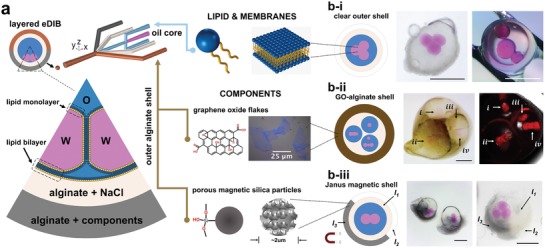Figure 4.

In the presence of phospholipids, droplet networks segregated by lipid bilayers may be formed within a triple emulsion. This creates encapsulated droplet interface bilayer networks (eDIBs) that can be patterned with functional materials using the fluidic patterning approach illustrated in Figure 3. a) The presence of amphiphilic phospholipids in the oil midphase serves as a surfactant, forming self‐assembled lipid monolayers, at each oil–water interface. b‐i) The contacting of two such aqueous interfaces results in the formation of a lipid bilayer between the aqueous volumes, creating lipid membranes between internal aqueous droplets, and the internal droplets and the hydrogel shell, where they make contact. Incorporation of two successive outer alginate coflows, in emulsion formation, can be used to form double‐layered hydrogel shells. These can be used to encapsulate droplet networks with Janus‐, or whole‐shell‐, patterning that incorporates functional materials, such as graphene oxide or silica magnetic particles. b‐ii) Bright‐field and fluorescent images of encapsulated droplet interface bilayers (eDIBs), with an outer hydrogel shell loaded with atomically thin graphene oxide (GO) sheets. b‐iii) Encapsulated droplet interface bilayers (eDIBs) with a double hydrogel shell, comprising an inert spacer shell, and an asymmetric Janus‐shell. The Janus shell incorporates silica magnetic microparticles to impart polarized magnetic properties on the membrane‐based artificial cell construct.
